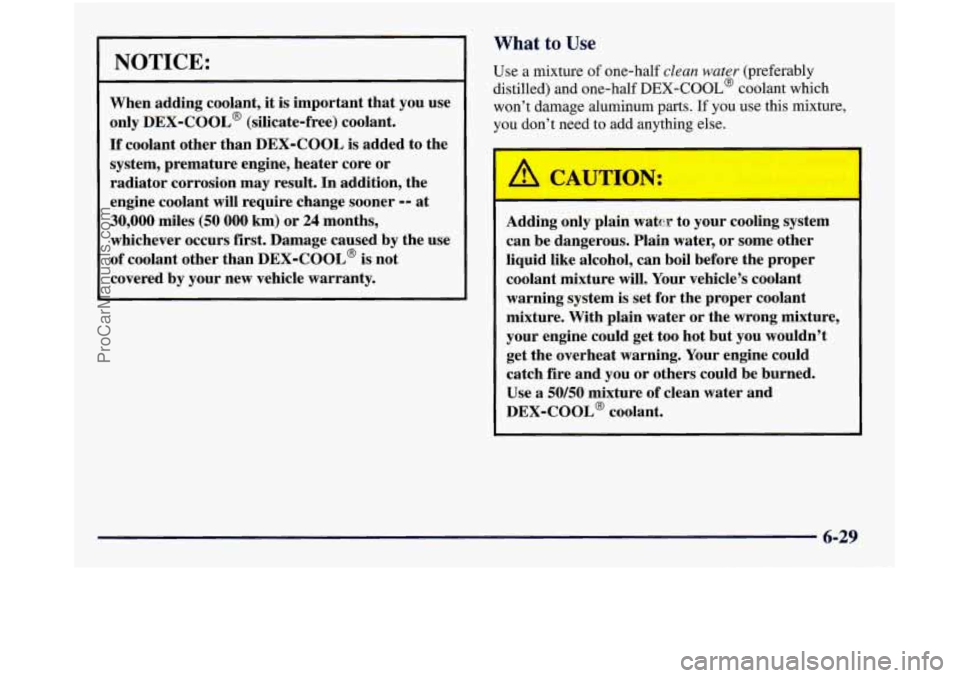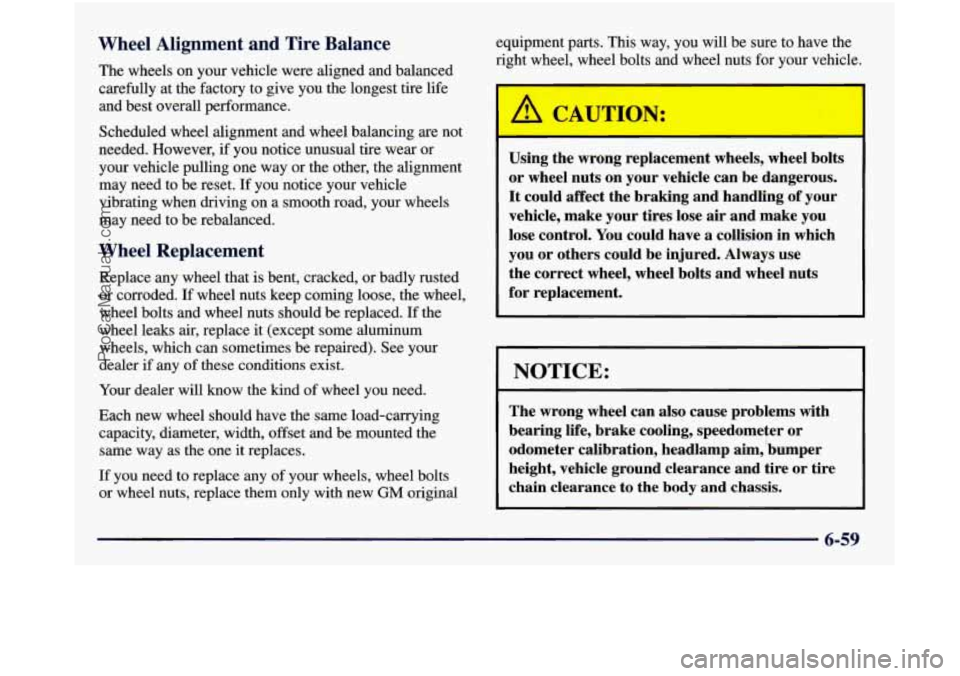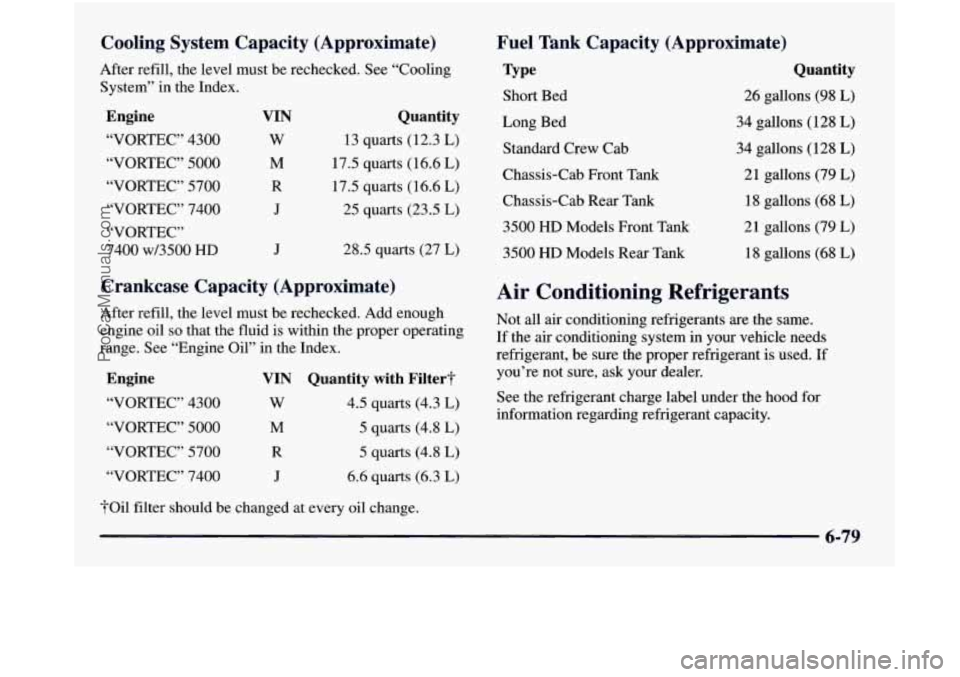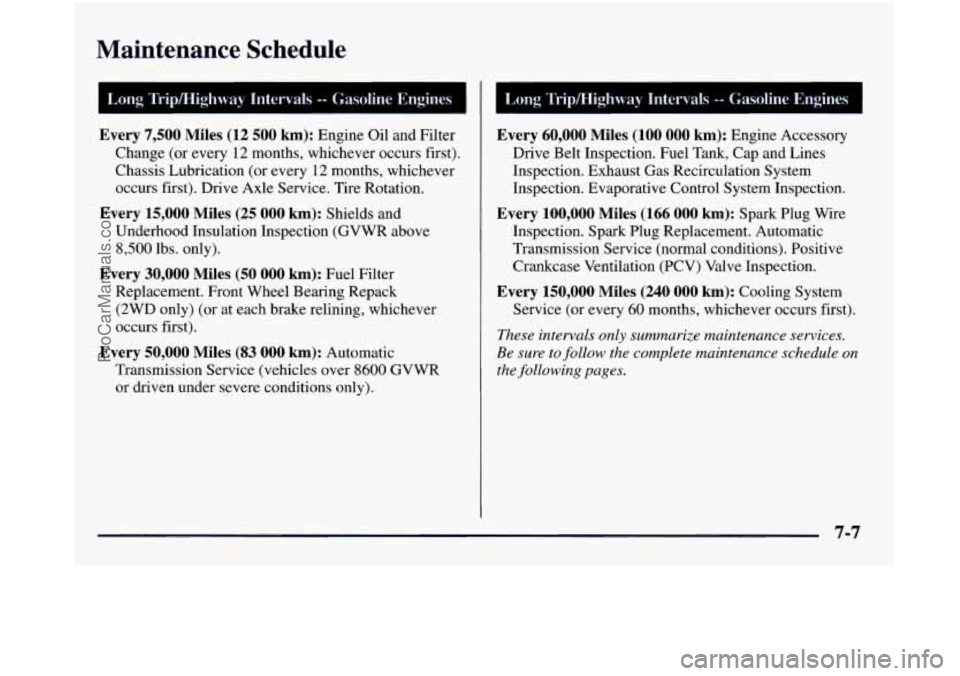Page 319 of 452

NOTICE:
When adding coolant, it is important that you use
only
DEX-COOL@ (silicate-free) coolant.
If coolant other than DEX-COOL is added to the
system, premature engine, heater core or
radiator corrosion may result. In addition, the
engine coolant will require change sooner
-- at
30,000 miles (50 000 km) or 24 months,
whichever occurs first. Damage caused by the use
of coolant other than DEX-COOL@ is not
covered by your new vehicle warranty.
What to Use
Use a mixture of one-half clean water (preferably
distilled) and one-half
DEX-COOL@ coolant which
won’t damage aluminum
parts. If you use this mixture,
you don’t need to add anything else.
CAUTION:
Adding only plain water to your cooling system
can be dangerous. Plain water, or some other
liquid like alcohol, can boil before the proper
coolant mixture will. Your vehicle’s coolant
warning system is set for the proper coolant
mixture. With plain water or the wrong mixture,
your engine could get too hot but you wouldn’t
get the overheat warning. Your engine could
catch fire and you or others could be burned.
Use a
50/50 mixture of clean water and
DEX-COOL@ coolant.
6-29
ProCarManuals.com
Page 320 of 452
- ~ ~~
NOTICE:
If you use an improper coolant mixture, your
engine could overheat and be badly damaged.
The repair cost wouldn’t be covered by your
warranty.
Too much water in the mixture can
freeze and crack the engine, radiator, heater core
and other parts.
If you have to add coolant more than four times a year,
have your dealer check your cooling system.
NOTICE:
If you use the proper coolant, you don’t have to
add extra inhibitors or additives which claim
to
improve the system. These can be harmful.
Checking Coolant
If your vehicle has a diesel engine, see “Checking
Coolant”
in the Diesel Engine Supplement.
,:. . .,. ..... I.. .;> .:... ...,,.. ::l:. ..
.. .
The coolant recovery tank is located on the passenger’s
side at the rear corner
of the engine compartment.
When your engine
is cold, the coolant level should be at
the
COLD mark, or a little higher. When your engine is
warm,
the level should be up to the HOT mark, or a
little higher.
6-30
ProCarManuals.com
Page 349 of 452

Wheel Alignment and Tire Balance
The wheels on your vehicle were aligned and balanced
carefully at the factory to give you the longest tire life
and best overall performance.
Scheduled wheel alignment and wheel balancing are not
needed. However,
if you notice unusual tire wear or
your vehicle pulling one way or the other, the alignment
may need to be reset.
If you notice your vehicle
vibrating when driving on a smooth road, your wheels
may need to be rebalanced.
Wheel Replacement
Replace any wheel that is bent, cracked, or badly rusted
or corroded. If wheel nuts keep corning loose, the wheel,
wheel bolts and wheel nuts should be replaced. If the
wheel leaks
air, replace it (except some aluminum
wheels, which can sometimes be repaired). See your
dealer if any
of these conditions exist.
Your dealer will know the kind of wheel you need.
Each new wheel should have the same load-carrying
capacity, diameter, width, offset and be mounted the
same way as the one it replaces.
If you need to replace any of your wheels, wheel bolts
or wheel nuts, replace them only with new
GM original equipment
parts. This way, you will be sure to have the
right wheel, wheel bolts and wheel nuts for your vehicle.
~ Using the wrong replacement wheels, wheel bolts
or wheel nuts on your vehicle can be dangerous.
It could affect the braking and handling of your
vehicle, make your tires lose air and make you
lose control. You could have a collision in which
you or others could be injured. Always use
the correct wheel, wheel bolts and wheel nuts
for replacement.
~
NOTICE:
The wrong wheel can also cause problems with
bearing life, brake cooling, speedometer or
odometer calibration, headlamp aim, 'bumper
height, vehicle ground clearance and tire or tire
chain clearance to the body and chassis.
6-59
ProCarManuals.com
Page 369 of 452

Cooling System Capacity (Approximate)
After refill, the level must be rechecked. See “Cooling
System” in the Index.
Engine
“VORTEC” 4300
“VORTEC” 5000
“VORTEC” 5700
“VORTEC” 7400
“VORTEC”
7400 w/3500 HD
VLN
w
M
R
J
J
Quantity
13 quarts (12.3 L)
17.5 quarts (16.6 L)
17.5 quarts (16.6
L)
25 quarts (23.5 L)
28.5 quarts (27
L)
Crankcase Capacity (Approximate)
After refill, the level must be rechecked. Add enough
engine oil
so that the fluid is within the proper operating
range. See “Engine Oil” in the Index.
Engine
“VORTEC” 4300
“VORTEC” 5000
“VORTEC” 5700
“VORTEC” 7400
VIN Quantity with Filter?
w 4.5 quarts (4.3 L)
M 5 quarts (4.8 L)
R 5 quarts (4.8 L)
J 6.6 quarts (6.3 L)
foil filter should be changed at every oil change.
Fuel Tank Capacity (Approximate)
PPe Quantity
Short Bed
26 gallons (98 L)
Long Bed
34 gallons (128
L)
Standard Crew Cab 34 gallons (128 L)
Chassis-Cab Front Tank 2 1 gallons (79 L)
Chassis-Cab Rear Tank
18 gallons (68
L)
3500 HD Models Front Tank
21 gallons (79 L)
3500 HD Models Rear Tank
18 gallons (68
L)
Air Conditioning Refrigerants
Not all air conditioning refrigerants are the same.
If the air conditioning system in your vehicle needs
refrigerant, be sure the proper refrigerant is used. If
you’re not sure, ask your dealer.
See the refrigerant charge label under the
hood for
information regarding refrigerant capacity.
6-79
ProCarManuals.com
Page 376 of 452
Maintenance Schedule
I Short Trip/City Intervals -- Gasoline Engines I
Every 100,000 Miles (166 000 km): Spark Plug Wire
Inspection. Spark
Plug Replacement. Automatic
Transmission Service (normal conditions). Positive
Crankcase Ventilation
(PCV) Valve Inspection.
Every 150,000 Miles (240 000 km): Cooling System
Service (or every
60 months, whichever occurs first). Follow this maintenance
schedule
only if none of the
conditions from the Short Trip/City Maintenance
Schedule is true.
Do not use this schedule if the vehicle
is used for trailer towing, driven in a dusty area or used
off paved roads. Use the Short Trip/City schedule for
these conditions.
Driving CI Ldzicle r+*ith CI fL1ly warmed engine urzder
highvvcry conditions
causes engine oil to break
dowm slorvcr.
7-6
ProCarManuals.com
Page 377 of 452

Maintenance Schedule
Long TriplHighway Intervals -- Gasoline Engines
Every
7,500 Miles (12 500 km): Engine Oil and Filter
Change (or every 12 months, whichever occurs first).
Chassis Lubrication (or every
12 months, whichever
occurs first). Drive Axle Service. Tire Rotation.
Every 15,000 Miles (25 000 km): Shields and
Underhood Insulation Inspection (GVWR above
8,500 lbs. only).
Every 30,000 Miles (50 000 km): Fuel Filter
Replacement. Front Wheel Bearing Repack
(2WD only) (or at each brake relining, whichever
occurs first).
Every 50,000 Miles (83 000 km): Automatic
Transmission Service (vehicles over
8600 GVWR
or driven under severe conditions only).
I Long; TripMighway Intervals -- Gasoline Engines I
Every 60,000 Miles (100 000 km): Engine Accessory
Drive Belt Inspection. Fuel Tank, Cap and Lines
Inspection. Exhaust Gas Recirculation System
Inspection. Evaporative Control System Inspection.
Every 100,000 Miles (166 000 km): Spark Plug Wire
Inspection. Spark Plug Replacement. Automatic
Transmission Service (normal conditions). Positive
Crankcase Ventilation (PCV) Valve Inspection.
Every 150,000 Miles (240 000 km): Cooling System
Service (or every
60 months, whichever occurs first).
These intervals only summarize maintenance services.
Be sure to follow the complete maintenance schedule on
the following pages.
7-7
ProCarManuals.com
Page 397 of 452
Short TripKity Maintenance Schedule -- Gasoline Engines
- In hilly or mountainous terrain.
- When doing frequent trailer towing.
- Uses such as found in taxi, police or delivery service.
Manual transmission fluid doesn’t require change.
previously and, therefore, haven‘t changed your automatic transmission fluid,
change both the fluid and filter.
Manual transmission fluid doesn’t require change.
17 Inspect Positive Crankcase Ventilation (PCV) valve.
Arz Emission Control Service.
0 If you haven’t used your vehicle under severe service conditions listed
150,000 Miles (240 000 km)
0 Drain, flush and refill cooling system (or every 60 months since last service,
whichever occurs first). See “Engine Coolant”
in the Index for what to use.
DATE
I MILEAGE ACTUAL I SERVICED BY:
Inspect hoses. Clean radiator, condenser, pressure cap and neck. Pressure test I I
cooling system and pressure cap.
AH Emission Control Service.
7-27
ProCarManuals.com
Page 409 of 452
1 Long Tripmighway Maintenance Schedule -- Gasoline Engines
150,000 Miles (240 000 km) DATE
Drain, flush and refill cooling system (or every 60 months since last service,
Inspect hoses. Clean radiator, condenser, pressure cap
and neck. Pressure test
the cooling system and pressure cap.
An Emissim Control Sc~l-~?ic.r.
whichever occurs first). See "Engine Coolant" in the Index for what to use. MILEAGE
7-39
ProCarManuals.com